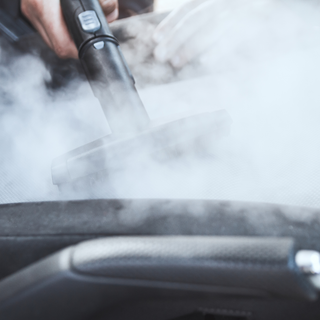Danger Of Steam On Glued panels:
Steam cleaning may appear to be the quick solution for removing dirt and stains from various surfaces, like vinyl and leather, but it can be risky when used on vinyl and leather that is bonded to a car's door card or dashboard. Understanding the potential dangers and effects on the glued backing is crucial.
Dangers of Steam Cleaning Leather & Vinyl on Door Cards & Dashboards:
- Heat Damage: Steam cleaning involves high temperatures, which can cause vinyl to warp or discolour. Vinyl is a type of plastic, and exposure to intense heat can make it lose its shape or shine. This can result in a permanently damaged surface.
- Glue Deterioration: The adhesive used to bond vinyl or leather to the door cards or dashboards can be particularly vulnerable to heat and moisture. Steam can soften and weaken the glue, causing the surface to peel away from the door card or dashboard.
- Moisture Penetration: Steam introduces a significant amount of moisture no matter how lightly you steam, which can seep into the underlying materials of the door card or dashboard. If the door card is made of porous materials like fibreboard or certain types of plastics, this moisture can cause warping, swelling, or even mould growth, especially in humid environments, as the moisture is trapped between layers on the door card or dashboard.
- Mildew and Mold Growth: The moisture from steam can get trapped between the vinyl/leather and the door card/dashboard. If it doesn't dry out properly, this can create a breeding ground for mildew and mould, which will smell in time and produce potentially harmful spores.
- Surface Damage: While steam can be effective at lifting dirt, it can also be too aggressive, especially if used incorrectly. It may strip away protective coatings or cause micro-abrasions on the leather or vinyl surface, making it more susceptible to future staining and damage.
What Happens to the Glued Backing?
When steam is used on leather & vinyl surfaces, the heat and moisture penetrate through the material and reach the adhesive layer. Most adhesives used in car interiors are designed to withstand some degree of heat, but not the intense and prolonged exposure that steam cleaning involves.
- Softening of Adhesive: The heat from the steam softens the adhesive. While softened, the adhesive loses its grip on the vinyl and the material its bonded to. This can lead to immediate or gradual peeling and delamination.
- Moisture Absorption: Steam introduces water into the adhesive layer, which can compromise its integrity. Water can dilute the adhesive, reducing its bonding strength and causing the material to lift away from the backing its bonded to.
- Reactivation of Adhesive: In some cases, heat can cause certain adhesives to become tacky again. This might temporarily improve the bond, but as the adhesive cools and moisture evaporates, it often results in a weaker bond than before.
To Sum It Up:
While steam cleaning can be an effective way to remove stubborn dirt and stains, it poses significant risks to vinyl bonded to car door cards. The heat and moisture can damage the material, weaken the adhesive, and potentially cause long-term issues such as mould growth and warping of underlying materials. For these reasons, it's recommended to use alternative cleaning methods that involve less heat and moisture, such as specialised vinyl or leather cleaners along with the correct brushes for the process. Always test a small, inconspicuous area first.
Always seek help from a professional if you’re not sure or if you gut instinct tells you is this right. A training course can help you understand a lot more.

